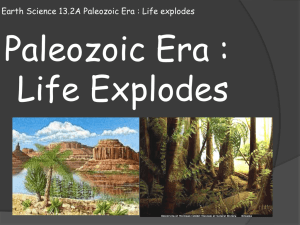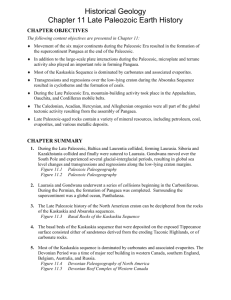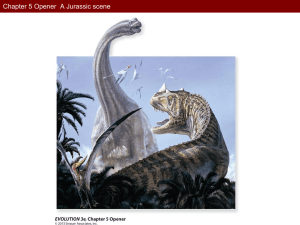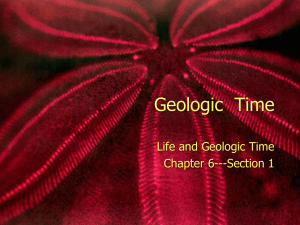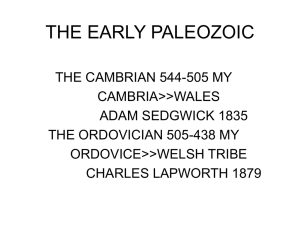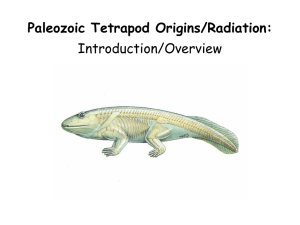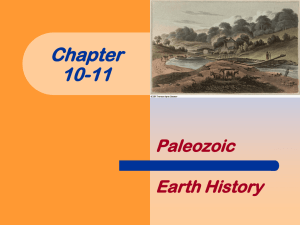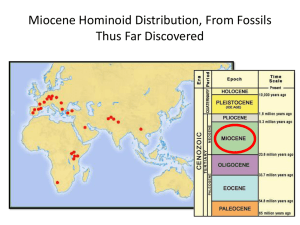Paleozoic Era - E. R. Greenman
advertisement
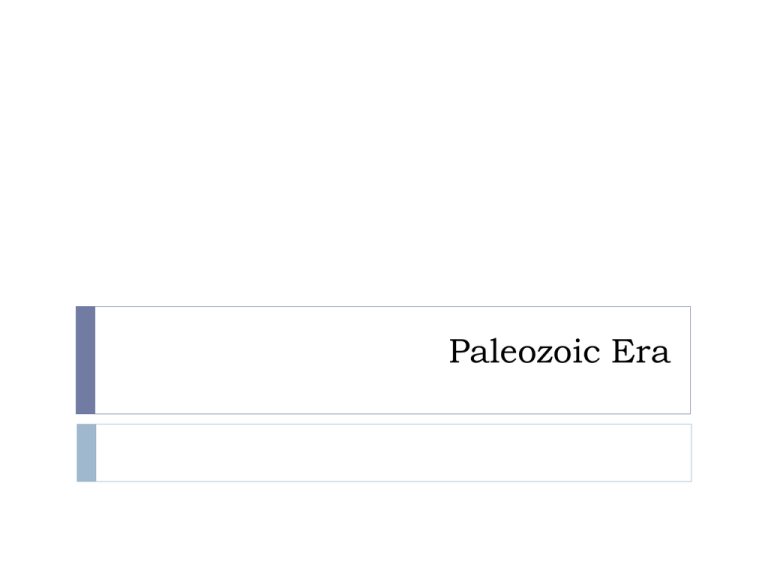
Paleozoic Era Continents in late Proterozoic Eon Cratons and Mobile Belts Rodinia began breaking apart sometime during the late Proterozoic By the beginning of the Paleozoic Era, six major continents were present Each continent can be divided into two major components a craton and one or more mobile belts Epeiric Seas Transgressing and regressing shallow seas called epeiric seas Common feature of most Paleozoic cratonic histories Cause unconformities Continental glaciation as well as plate movement caused changes in sea level Four Mobile Belts Four mobile belts formed around the margin of the North American craton during the Paleozoic Franklin mobile belt Cordilleran mobile belt Ouachita mobile belt Appalachian mobile belt Each was the site of mountain building in response to compressional forces convergent plate boundary formed such mountain ranges as the Appalachians and Ouachitas Paleozoic North America • Mobile belts Six Major Paleozoic Continents At the beginning of the Paleozoic, six major continents were present Baltica - Russia west of the Ural Mountains and the major part of northern Europe China - a complex area consisting of at least three Paleozoic continents that were not widely separated and are here considered to include China, Indochina, and the Malay Peninsula Gondwana - Africa, Antarctica, Australia, Florida, India, Madagascar, and parts of the Middle East and southern Europe Six Major Paleozoic Continents Kazakhstan - a triangular continent centered on Kazakhstan, but considered by some to be an extension of the Paleozoic Siberian continent Laurentia - most of present North America, Greenland, northwestern Ireland, and Scotland Siberia - Russia east of the Ural Mountains and Asia north of Kazakhstan and south Mongolia Besides these large landmasses, geologists have also identified numerous small microcontinents and island arcs associated with various microplates Major extinctions during Paleozoic Ordovician Silurian Devonian Permian Paleogeography of the World For the Late Cambrian Period EARTH HISTORY PALEOZOIC LIFE • In the earliest part of the Cambrian, a few small (several millimeters in size) shelly fossils are found, but then shortly afterwards life really “takes off ” with larger animals with hard skeletons and shells. M&W, Fig. 21.1a M&W, Fig. 21.1c M&W, Fig. 21.1b Lapworthella, Australia. An anabaritid, Northwest Territories, Canada. Archaeooides, Northwest Territories, Canada. EARTH HISTORY PALEOZOIC LIFE • What advantages do SHELLS provide? -Protection from predators M&W, Fig. 21.1a Lapworthella, Australia. -Protection from UV light (allowing animals to move into shallower water) -When the tide goes out, shelled organisms don’t dry out -Shells provide structural support for larger and larger organisms to evolve Early History—Paleozoic Era Cambrian Period 543-490 mya Trilobites, sponges, brachiopods live in oceans Early History—Paleozoic Era Cambrian Period 543-490 mya Global warming as Rodinia breaks up Laurentia, Kazahkstan, Siberia move toward equator Sea level rises as ice melts Deposition of limestone common Early History—Paleozoic Era Cambrian Period Ordovician Period 490-443 mya Trilobites, corals, algae, brachiopods, molluscs, in complex reef systems First lichens and bryophytes on land Major extinction at end of period due to ice age Early History—Paleozoic Era Cambrian Period Ordovician Period 490-443 mya Laurentia begins to collide with Europe (mountain building) Gondwana moves over pole Land is cold and barren, warm tropical shallow marine near equator Ice age toward end of Ordovician Paleogeography of the World For the Late Ordovician Period Early History—Paleozoic Era Cambrian Period Ordovician Period Silurian Period 443-417 mya Abundant life in ocean, coral reefs in shallow marine near equator Jawless fish common Echinoderms and molluscs flourish, trilobites begin to decline First plants on land First terrestrial arthropods Early History—Paleozoic Era Cambrian Period Ordovician Period Silurian Period 443-417 mya Gondwana moves more across south pole Laurentia, Siberia, Baltica move toward each other at equator Early Silurian glaciers melt and sea level rises toward end of Silurian (greenhouse effect) Paleogeography of the World For the Middle Silurian Period Early History—Paleozoic Era Devonian Period 417-354 mya Many mountain building events Abundant marine life including bony fish First sharks First ferns on land as well as tree-like plants First tetrapods and first terrestrial arthropods Late Devonian extinction: 70% of invertebrate species (especially marine) Map Early History—Paleozoic Era Devonian Period 417-354 mya Many mountain building events Two supercontinents: Gondwana and Euramerica Both continents slowly drift north Map Map Early History—Paleozoic Era Carboniferous Period 354-290 mya Missisippian (354-318 mya) Pennsylvanian (318-290 mya) Fish expand in oceans, many molluscs, corals, few trilobites. Forests and swamps with seed plants on land Winged insects Early amphibians on land. Early History—Paleozoic Era Carboniferous Period 354-290 mya Many episodes of mountain building Inland seas reduced due to beginning collision of continents to form Pangaea Ice develops over Gondwana due to climate change Land dries due to changes in glaciation and Pangaea Early History—Paleozoic Era Permian Period 290-248 mya Life in oceans diminishes Predatory ammonites First vertebrate herbivores on land. Reptiles common on land Many insects on land Many gymnosperm plants 90% of marine species experience extinction at end of period (Pangaea, flood basalts in Siberia, impact) Early History—Paleozoic Era Permian Period 290-248 mya Climate becomes dryer Pangaea assembled, with only Chinas and Kazahkstan separated Warming climate, dry interior of continent Pangaea!
